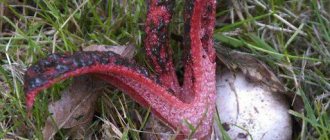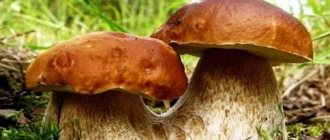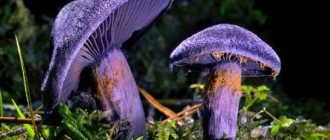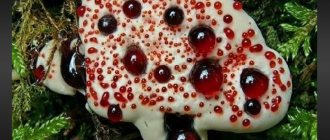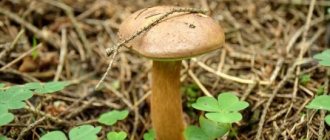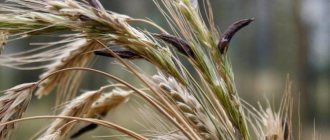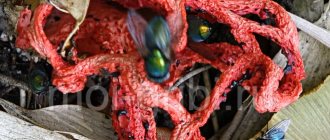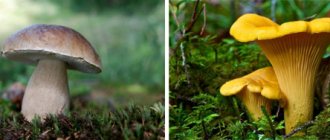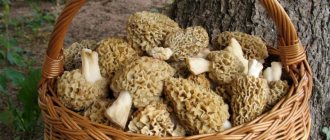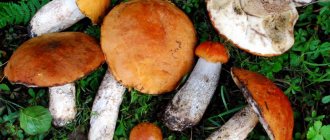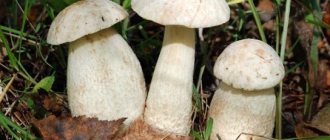A large number of species of edible and inedible mushrooms grow on the territory of the Russian Federation. They are found in almost all climatic zones and are familiar to everyone. Among the variety of mushrooms there are common milk mushrooms, honey mushrooms, and chanterelles, which are not difficult to find in almost any forest. But there are also rare species of mushrooms, many of which have unusual shapes, colors, and properties. For various reasons, their numbers are very small, therefore, in order to protect and save them from extinction, they are listed in the Red Book of Russia.
White boletus
This is an edible mushroom found in many regions of Russia. The color of the mushroom is almost completely white, only the skin on the cap may have a pinkish, brownish or yellowish tint, visible upon closer inspection. It is distinguished by a high leg with a thickening at the bottom. The lower part, closer to autumn, often has a bluish tint. White boletus is found between June and September.
Mycena chlorophos
The next unusual mushroom glows in the dark. This is Mycena chlorophos. It is found in Japan, subtropical Asia, Polynesia, Java and Sri Lanka, Brazil and Australia. They contain biological luminescent substances that emit a gentle green light in the dark. The glow is especially visible when the air temperature is around 21°C. As it matures and pores form, the glow becomes less intense and noticeable.
9
Girlish umbrella mushroom
It is a “relative” of champignons, and therefore edible. This mushroom is extremely rare and is included in the Red Books of some regions of Russia. It is quite easy to recognize the umbrella mushroom. Its cap is white and shaped like an umbrella or bell. Almost its entire surface is covered with a kind of fringe. The pulp of the mushroom smells like radish and acquires a reddish tint when cut.
Mushroom places in the Moscow region
In the Moscow region there are dozens of mushroom places rich in a wide variety of species. Since the region is widely spread both to the south and to the north, there are mushroom places in every region. The most popular mushroom destinations in the Moscow region:
- Ruza district is one of the richest mushroom areas. The environment here is the cleanest. There are a variety of mushrooms, but honey mushrooms grow the most.
- Stupinsky district - many places with porcini mushrooms.
- Yegoryevsky district - not far from the villages of Savvino, Kostino, Shuvoe you can collect more than one basket of white boletus, boletus, aspen boletus, chanterelles, honey mushrooms, umbrellas and many others.
- Odintsovo district: porcini mushrooms, honey mushrooms. They grow near the villages of Uspenskoye and Nazaryevo.
- The Klin region is rich in white and boletus.
- Kolomna district . The forests of this area are rich in all types of mushrooms: porcini mushrooms, honey mushrooms, milk mushrooms, boletus mushrooms, oyster mushrooms, boletus and capillary mushrooms, chanterelles and russula.
- The Dmitrovsky district is famous for chanterelles, boletus, and boletus.
- The Meshchersky district is distinguished by mushroom places near the city of Roshali. Chanterelles, porcini mushrooms, boletus mushrooms, boletus mushrooms, boletus mushrooms and milk mushrooms - all these mushrooms are often found there.
In order not to get confused in this mushroom diversity, it is worth studying the descriptions of edible mushrooms in this area.
Mutinus canis
The mutinus mushroom is difficult to confuse with others due to its original elongated shape. The fruiting body is usually white or pink in color and grows up to 18 centimeters in length. Mutinus is different in that it does not have a cap. Instead, there is a small opening of the inner part. Despite the unpleasant smell, the canine mutinus can be eaten, but only until it comes out of the egg shell.
List of fish, reptiles and amphibians in the Red Book of Moscow and Moscow Region
Sterlet
Lives in river beds. Demanding on the amount of oxygen and purity of water. Previously, the main fish stocks were concentrated in the river. Oka. Recently, the number has decreased, but increased in the river. Moscow. Also found in the Osetr and Klyazma rivers.
Sterlet
Sinets
Fish that lives in rivers and lakes. Up to 30 cm in length, weight no more than 600 g. Leads a gregarious lifestyle. Found in the Ivankovskoye Reservoir and the Oka River. Rare species status.
Sinets
Common catfish
Known for its large size, up to 5 m in length, and weighing up to 300 kg. But recently the maximum weight of catfish is 10 kg. Found in the rivers: Oka, Moscow, Klyazma, Sestra, as well as the Ivankovo Reservoir. Endangered.
Common catfish
Common copperhead
It is found in various types of forests, but prefers open areas. The diet consists of lizards and other snakes, occasionally chicks and mammals. Aggressive, but not dangerous to humans. There are isolated cases of detection of copperhead in some areas of the region. The species is endangered.
Common copperhead
Fast lizard
A lizard about 25 cm long. It feeds on insects, larvae, and caterpillars. The range unevenly covers the entire region, but the number of the species has been declining, especially over the past decades.
Fast lizard
Interesting fact : for protection purposes, the lizard can cast off its tail, which grows back in 3-4 weeks. Instead of a spine, cartilage appears in the tail. The secondary tail has a different color and scale shape.
Crested newt
The length of males is up to 18 cm, females - on average 15 cm. Newts live part of the year in fresh water bodies, partly on land, in forests. They are more common in the western regions of the region. The species has a vulnerable status.
Crested newt
Red-bellied Firebird
No more than 6 cm in length. Feeds on insects. Inhabits areas of steppes and forest-steppes. Within the region, the toad can often be found in areas south of Moscow, and occasionally in the west. The number of fire-bellied toads is declining; it is a vulnerable species.
Red-bellied Firebird
Amanita cone-shaped
A rare mushroom that grows exclusively on calcareous soils. The fruiting body of the mushroom is large. The cap reaches 16 centimeters in diameter, the leg is swollen at the base. Both the cap and the stem have a coating consisting of flocculent scales. Unlike classic fly agaric mushrooms, the mushroom does not have red shades in color, as well as pronounced spots on the surface of the cap.
Double net carrier
Belongs to the phallomycete fungi. It grows best on heavily rotting wood or humus, and therefore is more often found in deciduous forests. The shape of the mushroom is unusual. In a mature state, the part responsible for the spread of spores hangs from under the cap almost to the ground. The networt is an edible mushroom. For unknown reasons, its numbers are steadily declining, as a result of which it is included in the Red Data Books of several countries.
Glowing Mycena chlorophos
Beautiful mycenae with lacy bell-shaped caps are also among the rarest mushrooms in the world. They can be found exclusively in the lands of Malaysia and Indonesia, Mexico and Brazil, as well as in some provinces of Japan. Mycenae prefer to settle on clearly visible branches and roots of trees, as well as open deciduous soil.
Spectacular representatives of the mushroom kingdom are also amazing because they can glow from the inside. They emit a fairly intense glow, which is easy to notice from a distance of several meters. The bioluminescence effect in these amazing organisms is possible due to the natural oxidation process of a light-emitting biological pigment called luciferin. They need the glow to attract representatives of the fauna, which, through the spread of spores, contribute to the proliferation of fungi.
Gyropor chestnut
The chestnut gyroporus has a classic shape, consisting of a stem and a pronounced cap. The surface of the cap can be smooth or covered with barely noticeable fluffy fibers. The mushroom stem has a spongy structure, with voids inside. When mature, the mushroom breaks easily. The flesh of the gyropore is white. In some subspecies, its color changes dramatically when a cut is made.
Insects
Mantises
Common mantis (Mantis religiosa) - restored and recovering species
Coleoptera or Beetles
Adonis leaf beetle (Entomoscelis adonidis) - a species on the verge of extinction
Akimerus schaefferi - vulnerable species
Aphodius ivanovi - vulnerable species
Greater tot (Pachylister inaequalis) - an endangered species
Great Shortwing (Necydalis major) - vulnerable species
Greater black spruce beetle (Monochamus urussovi) - an understudied species
Warty omias (Omias verruca) - a species on the verge of extinction
Bronze beauty (Calosoma inquisitor) - vulnerable species
Wax hermit (Osmoderma barnabita) - a species on the verge of extinction
Eight-spotted waxwing (Gnorimus variabilis) - a species on the verge of extinction
Convex ground beetle (Carabus convexus) - vulnerable species
German racer (Cylindera germanica) - vulnerable species
Smooth bronze (Protaetia aeruginosa) - a species on the verge of extinction
Oak stenocorus (Stenocorus quercus) - vulnerable species
Great crusader ground beetle (Panagaeus cruxmajor) - vulnerable species
Shcheglov's ground beetle (Carabus stscheglowi) - vulnerable species
Stag beetle (Lucanus cervus) - a critically endangered species
Green leptura (Lepturobosca virens) - vulnerable species
Green-headed lebia (Lebia chlorocephala) - vulnerable species
Golden ground beetle (Carabus clathratus) - vulnerable species
Golden-crowned beauty (Calosoma auropunctatum) - an understudied species
Toothed Drypta (Drypta dentata) - an insufficiently studied species
Variable dung beetle (Geotrupes mutator) - vulnerable species
The flat tot (Hololepta plana) is a vulnerable species
Crusader corneater (Dorcadion equestre) - vulnerable species
Koehler's redwing (Purpuricenus kaehleri) - vulnerable species
The globulous redwing (Purpuricenus globulicollis) is an understudied species
Moon copter (Copris lunaris) - an endangered species
Marbled beetle (Polyphylla phullo) - vulnerable species
Musk beetle (Aromia moschata) - vulnerable species
The common snail eater (Cychrus caraboides) is an insufficiently studied species
Single-horned staghorn (Sinodendron cylindricum) - vulnerable species
Banded slug beetle (Chlaenius spoliatus) - vulnerable species
Deer (Dorcus parallelopipedus) - a species on the verge of extinction
Excellent racer (Cicindela soluta) - vulnerable species
Scented beaut (Calosoma sycophanta) - a species on the verge of extinction
Bandaged homophron (Omophron limbatum) - vulnerable species
Field ground beetle (Carabus arcensis) - vulnerable species
Field racer (Cicindela campestris) - vulnerable species
Polystichus connexus - vulnerable species
Coastal racer (Cicindela maritima) - an insufficiently studied species
Spotted leptura (Leptura maculata) - vulnerable species
Steppe beetle (Calosoma denticolle) - an insufficiently studied species
Steppe slugger (Blaps halophila) - vulnerable species
The crackling bombardier (Brachinus crepitans) is a vulnerable species.
Black-tailed Odacantha (Odacantha melanura) - vulnerable species
Shagreen ground beetle (Carabus coriaceus) - an insufficiently studied species
Spiny dung beetle (Geotrupes spiniger) - vulnerable species
Hymenoptera
Armenian bumblebee (Bombus armeniacus) - vulnerable species
The Baikal bumblebee (Bombus subbaicalensis) is an insufficiently studied species
Giant Scolia (Scolia maculata) - an insufficiently studied species
Clay bumblebee (Bombus argillaceus) - an understudied species
Giant bumblebee (Bombus fragrans) - a species on the verge of extinction
The reddish bumblebee (Bombus ruderatus) is an endangered species
Red-breasted carpenter ant (Camponotus herculeanus) - vulnerable species
Summer bumblebee (Bombus solstitialis) - vulnerable species
The lesser rock bumblebee (Bombus derhamellus) is an endangered species.
Moss bumblebee (Bombus muscorum) - a restored and recovering species
The sombre bumblebee (Bombus tristis) is a vulnerable species.
Clumsy German (Ronisia brutia) - an understudied species
The common bumblebee (Bombus proteus) is an endangered species
Megachile rotundata - vulnerable species
Variegated bumblebee (Bombus soroeensis) - vulnerable species
Lamellar-toothed bumblebee (Bombus serrisquama) - vulnerable species
The northern wood ant (Formica aquilonia) is an understudied species
Steppe Scolia (Scolia hirta) - vulnerable species
The steppe bumblebee (Bombus pomorum) is an endangered species
The bumblebee (Bombus confusus) is an insufficiently studied species
Semenov-Tyan-Shansky's bumblebee (Bombus semenoviellus) is a vulnerable species
Bumblebee (Bombus distinguendus) - vulnerable species
Orthoptera
Sevchuk Laxman (Onconotus laxmanni) - an insufficiently studied species
Steppe rack (Saga pedo) - a species on the verge of extinction
The snapping moth (Psophus stridulus) is a vulnerable species.
The tailed grasshopper (Tettigonia caudata) is an understudied species
Homoptera
Mountain cicada (Cicadetta montana) - vulnerable species
Polish cochineal (Porphyrophora polonica) - extinct species
Dragonflies
Swamp dragonfly (Leucorrhinia pectoralis) - vulnerable species
Blue rocker (Aeschna juncea) - vulnerable species
Yellowlegged damsel (Gomphus flavipes) - an understudied species
Yellow-spotted grandma (Somatochlora flavomaculata) - vulnerable species
Common platypod (Platycnemis pennipes) - vulnerable species
Dubious dragonfly (Leucorrhinia dubia) - vulnerable species
Lepidoptera
Acacia tail (Nordmannia acaciae) - vulnerable species
Arethusa (Arethusana arethusa) - a species on the verge of extinction
Birch silkworm (Endromis versicolora) - an understudied species
Marsh blueberry (Maculinea teleius) - vulnerable species
Greater urticaria (Nymphalis xantomelas) - vulnerable species
Greater Moth (Apatura iris) - a species on the verge of extinction
Great fathead (Muschampia tessellum) - vulnerable species
Death's head hawk moth (Acherontia atropos) - an insufficiently studied species
Briseid (Chazara briseis) - an understudied species
Beech corydalis (Stauropus fagi) - vulnerable species
The brown bear (Hyphoraia aulica) is an understudied species
Convolvulus hawk moth (Agrius convolvuli) - vulnerable species
Ocellated moth (Zygaena carniolica) - vulnerable species
Alcetas blueberry (Cupido alcetas) - an extinct species
Blue arion (Maculinea arion) - an endangered species
Meleager blueberry (Polyommatus daphnis) - vulnerable species
Orion blueberry (Scolitantides orion) - vulnerable species
Schiffermüller's blueberry (Pseudophilotes vicrama) - vulnerable species
Dryad (Satyrus dryas) - an understudied species
Oak zephyr (Quercusia quercus) - a species on the verge of extinction
Oak moth (Lasiocampa quercus) - vulnerable species
Oakleaf moth (Gastropacha quercifolia) - vulnerable species
Yellow Ribbon (Catocala fulminea) - Vulnerable Species
Yellow meadow moth (Tephrina arenacearia) - endangered species
Honeysuckle bumblebee (Hemaris fuciformis) - vulnerable species
Greenish pearl (Argynnis laodice) - vulnerable species
The ground wood borer (Paracossulus thrips) is an insufficiently studied species
Golden yellowthroat (Colias chrysotheme) - vulnerable species
V-white toothfly (Nymphalis vaualbum) - vulnerable species
Whitehead (Pyrgus alveus) - vulnerable species
Bordered moth (Comibaena bajularia) - vulnerable species
Beautiful blueberry (Polyommatus bellargus) - vulnerable species
The beautiful mother of pearl (Clossiana titania) is an understudied species
Red-bellied Ribbon (Catocala pacta) - Vulnerable Species
Blood bear (Tyria jacobaeae) - vulnerable species
Large-eye (Lopinga achine) - restored and recovering species
Linden hawk moth (Mimas tiliae) - an endangered species
The Little Blueberry (Cupido minimus) is an endangered species.
Lesser red ribbon (Catocala promissa) - endangered species
The crimson ribbon (Catocala sponsa) is an endangered species.
Hera bear (Euplagia quadripunctaria) - vulnerable species
Ursa caja (Arctia caja) - restored and recovering species
Lady bear (Callimorpha dominula) - vulnerable species
Mnemosyne (Parnassius mnemosyne) - vulnerable species
Morpheus (Heteropterus morpheus) - restored and recovering species
Common toothwing (Carchorodus alceae) - vulnerable species
Common Apollo (Parnassius apollo) - a species on the verge of extinction
Common tongue tongue (Macroglossum stellatarum) - restored and recovering species
Podalirius (Iphiclides podalirius) - a species on the verge of extinction
Polyxena (Zerynthia polyxena) - vulnerable species
Proserpine (Proserpinus proserpina) - vulnerable species
Purple bear (Rhyparia purpurata) - vulnerable species
Spotted bear (Chelis maculosa) - an understudied species
Variegated moth (Epirranthis diversata) - an insufficiently studied species
Broom yellowtail (Colias myrmidone) - restored and recovering species
Russian laceweed (Melanargia russiae) - vulnerable species
Red peacock eye (Aglia tau) - a species on the verge of extinction
Lilac Hawkmoth (Sphinx ligustri) - vulnerable species
Scabious bumblebee (Hemaris tityus) - vulnerable species
Steppe whiteweed (Pontia chloridice) - restored and recovering species
Meadowsweet (Neptis rivularis) - vulnerable species
Terzamon (Lycaena thersamon) - vulnerable species
Poplar ribbon grass (Limenitis populi) - an endangered species
Peat blueberry (Plebeius optilete) - extinct species
Peat jaundice (Colias palaeno) - a species on the verge of extinction
Peat mother of pearl (Clossiana eunomia) - an extinct species
Decorated Eversmannia (Eversmannia exornata) - an understudied species
Phryne (Triphysa phryne) - extinct species
Black-backed blueberry (Maculinea nausithous) - a species on the verge of extinction
Nigella ligea (Erebia ligea) - an insufficiently studied species
Black jellyfish (Erebia medusa) - an extinct species
Maturna checkerwort (Euphydryas maturna) - an endangered species
Spurred armyworm (Periphanes delphinii) - a critically endangered species
Bristle-footed army dove (Schinia cardui) - vulnerable species
Grille red
This mushroom does not have a cap. When mature, the fruiting body turns red and takes the shape of a ball. Its structure is heterogeneous and has openings, which is why the mushroom looks like a lattice. The spongy pulp has a rotten odor. The red trellis grows on rotting wood or leaves, is an extremely rare mushroom and is listed in the Red Book of Russia.
Milky blue
This purple beauty was discovered in the mixed forests of East Asia, North and Central America. Belongs to the Russula family. It is quite brittle in structure. When the milkweed breaks, a beautiful blue milk begins to ooze from it. Although it looks suspiciously poisonous, it can be eaten. In places where it grows, it can often be seen for sale. By the way, on our website topcafe.su you can see an article about the most poisonous mushrooms in the world.
4
Alpine hedgehog
Externally, the hedgehog resembles white coral. Its fruiting body is pure white and has virtually no odor. As a place of growth, the fungus chooses trunks and stumps of dead deciduous trees. Despite its strange shape, the hedgehog is edible, but only when young. It is better not to eat middle-aged and mature mushrooms. This mushroom is extremely rare and is listed in the Red Book of Russia.
Trembling orange
Oddly enough, the jelly-like shapeless mass on the trees is the edible orange tremors mushroom. It doesn’t look very good, of course: the sticky, trembling mushroom body, up to 10 cm in size, is slightly transparent, colored yellow-orange.
In dry summers, almost all the liquid from the tremors evaporates, and the mushroom turns into a kind of crust, but after heavy rains it swells again and acquires its former gelatinous structure. But the bright orange color disappears in rainy summers, giving way to a white, almost transparent color.
The trembler can also often be found on certain tinder fungi - this is how its natural parasitic properties are manifested. Young gelatinous mushrooms are considered a delicacy, especially in China, where they are used in soup. Old mushrooms are not suitable for culinary masterpieces - they are very tough.
Gyroporus blue
A mushroom with a cap up to 15 centimeters in diameter. The skin of the cap has a yellowish, brownish or brownish tint. A characteristic feature is blue discoloration when pressed. Hyroporus blue is distinguished by a change in color when the fruiting body is cut. With a violation of its integrity, it is repainted from white to a beautiful cornflower blue color. This mushroom can be eaten and is successfully used in cooking.
Bleeding tooth
Photo: kiddyclub.ru
The mushroom, which has a terrifying appearance, is common in Europe and North America. Also in recent years, it has begun to be found in Korea and Iran.
Young mushrooms exude a rich red juice on their white surface that looks like blood. Similar associations influenced its name.
Some experts argue that this mushroom can become an analogue of penicillin, since scientists have established its anti-inflammatory properties.
It is considered unsuitable for food as it has a bitter taste.
Rogatik pistil
This mushroom has an unusual shape and a complete absence of a cap. The fruiting body reaches 30 centimeters in height and 6 centimeters in diameter. At an early age, the outer surface of the leg is smooth, but later becomes covered with grooves. The color of an adult mushroom is rich ocher. The common hornet can be eaten, but it has very mediocre taste.
Gossamer violet
A mushroom with a dark purple cap up to 15 centimeters in diameter. The shape of the cap varies depending on age. At an early age it is convex, and later tends to a prostrate shape. The mushroom grows in coniferous and deciduous forests in many countries. In Russia, it is most widespread in the European part of the country.
Sparassis curly
It grows on the roots of trees and is a parasite, as it causes red rot on the tree trunk. It has many popular names, for example, “curly flake.” The fruiting body of this mushroom is bush-shaped with many growths. Despite its unconventional shape, curly sparassis is edible. The number of this sparassis is small, which is why it is included in the Red Book of Russia.
False morel
False morels of the species Gyromitra esculenta
in appearance they are very similar to the brain, only dark purple or brown in color. These mushrooms are also called “beefsteak mushrooms” because they are a delicacy when cooked correctly. If you do not have the skills to prepare this mushroom, then such a dish can be fatal. In their raw form, these mushrooms are poisonous and before using it in a recipe, if you are of course willing to take the risk, it must be carefully steamed.
Pine cone mushroom
An edible mushroom with a cap up to 15 centimeters in diameter. The shape of the cap varies greatly depending on the age of the mushroom. The taste of the mushroom is mediocre; it does not have a pronounced taste or smell. When cut, the pulp acquires a reddish tint and then slowly turns black. It grows actively throughout the warm season, most widely in deciduous forests.
